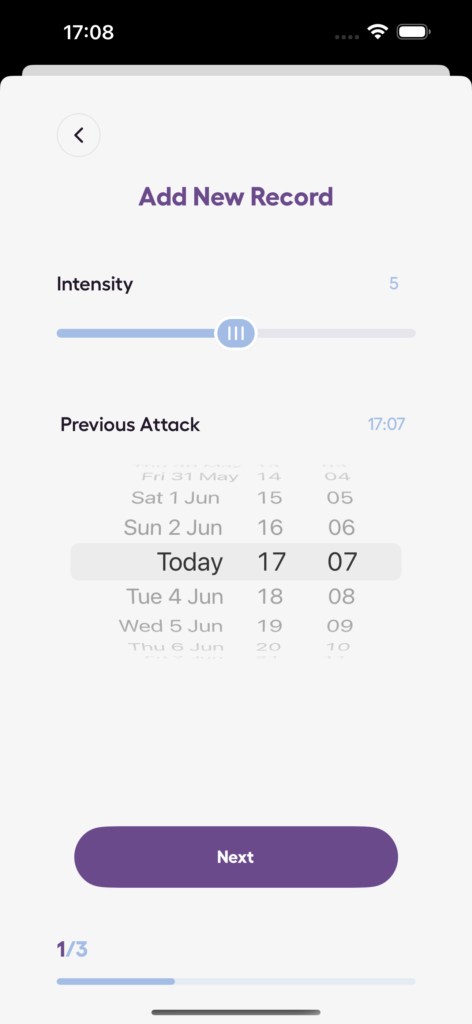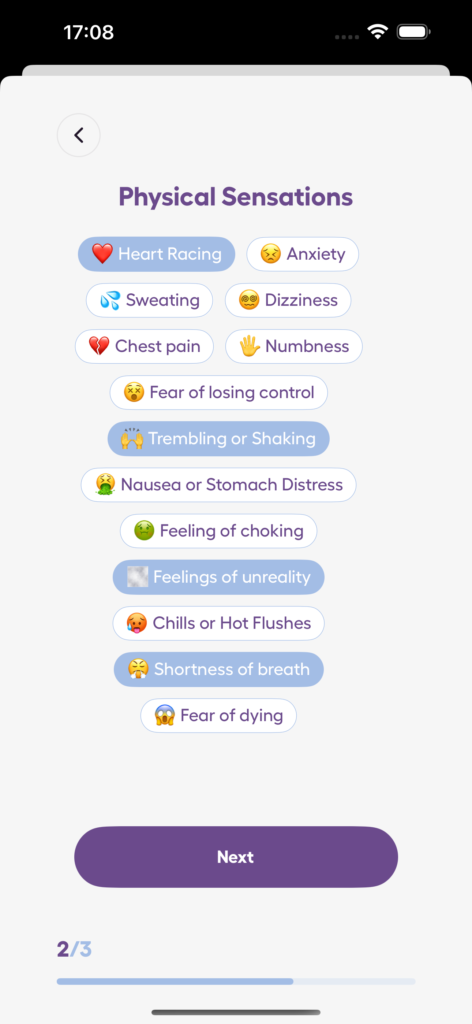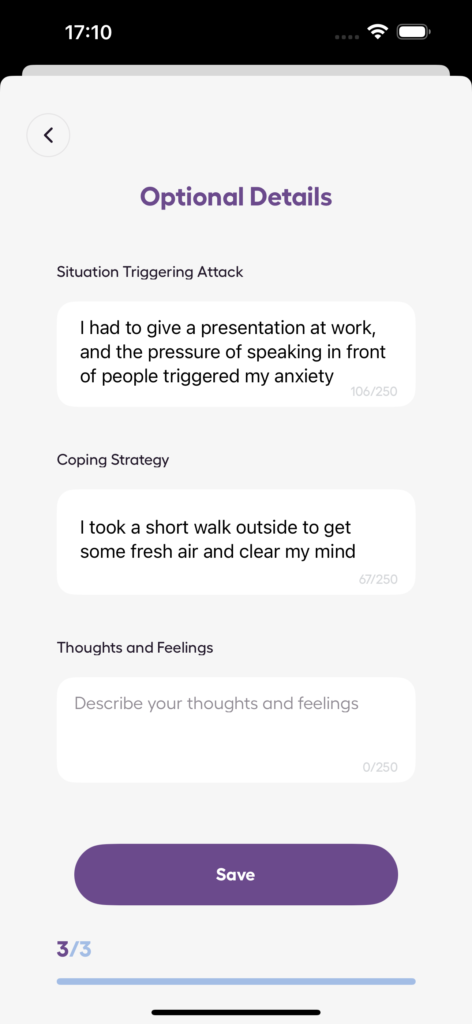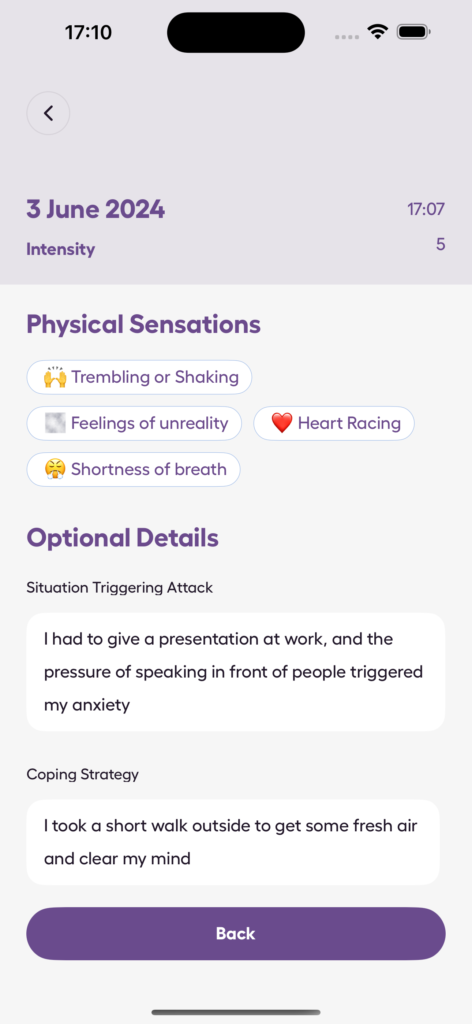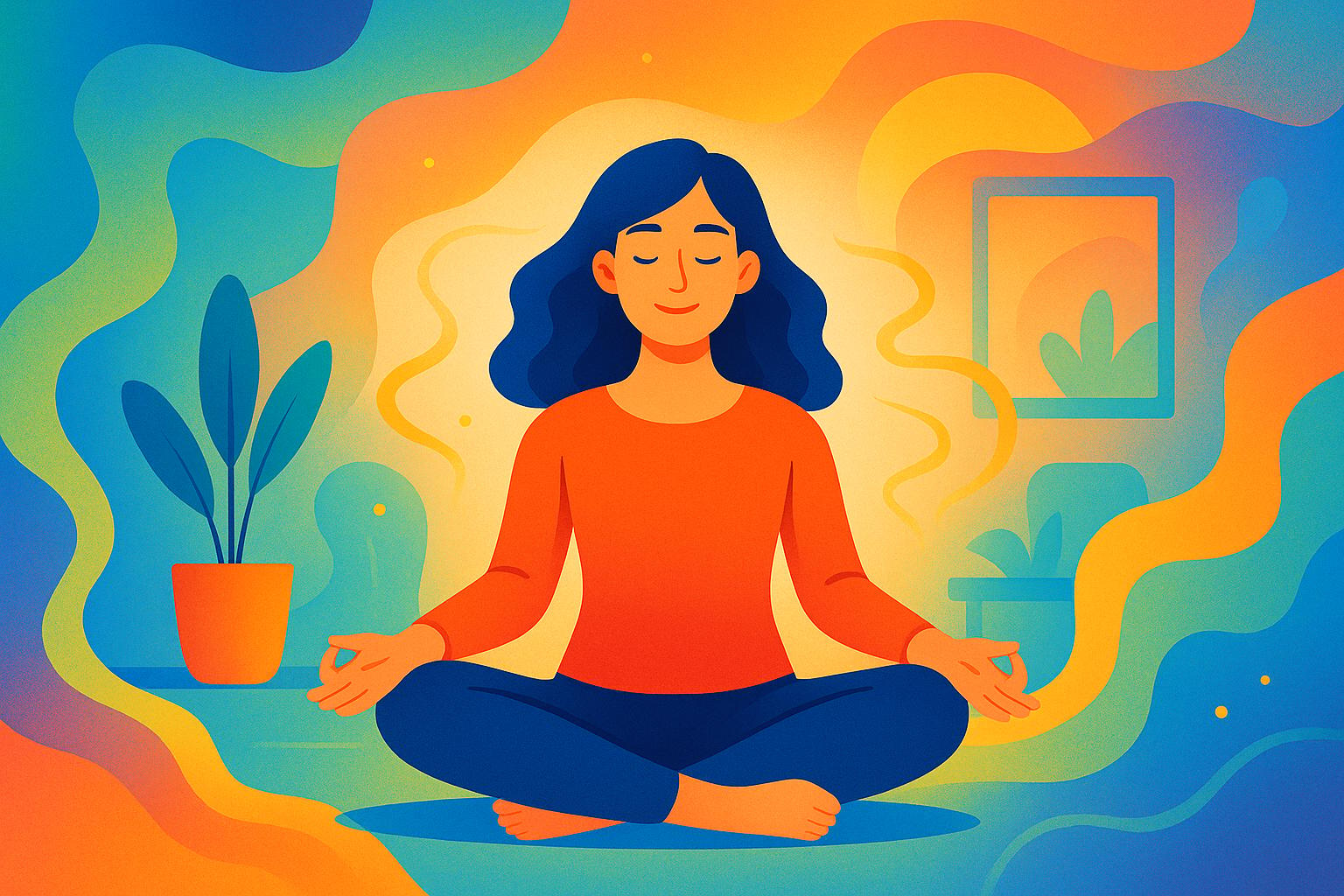Panic attacks hit hard and fast, feeling like a freight train of fear. Here’s what you need to know:
- Panic attacks are intense bursts of anxiety, peaking within minutes
- They cause both physical and mental symptoms
- Attacks typically last 5-30 minutes
- About 11% of Americans experience a panic attack yearly
- They’re scary but not dangerous
Key symptoms include:
- Racing heart
- Chest pain
- Shortness of breath
- Dizziness
- Sweating
- Nausea
- Feeling of unreality
| Treatment | Description |
|---|---|
| Therapy | CBT helps change thought patterns |
| Medication | SSRIs or SNRIs can reduce symptoms |
| Self-help | Breathing exercises, mindfulness, exercise |
Remember: Panic attacks are treatable. With proper help and management, you can regain control.
Related video from YouTube
Basics of panic attacks
Panic attacks are intense bursts of fear that hit hard and fast. Let’s explore what they are, how they differ from anxiety attacks, and who’s most likely to experience them.
Panic attack definition
A panic attack is a sudden rush of fear or discomfort that peaks within minutes. It’s not just nerves – it’s a full-blown physical and mental reaction.
Panic attacks:
- Strike suddenly, even during sleep
- Cause intense physical symptoms
- Usually peak within 10 minutes, rarely lasting over an hour
"Panic attacks are like anxiety’s evil twin. They’re short, but boy do they pack a punch. They feel like the end of the world, but they’re not actually dangerous." – HelpGuide.org
Panic attacks vs. anxiety attacks
People often confuse panic and anxiety attacks, but they’re different:
| Feature | Panic Attacks | Anxiety Attacks |
|---|---|---|
| Onset | Sudden | Gradual |
| Trigger | Often none | Usually tied to a stressor |
| Intensity | Very intense | Less intense |
| Duration | Minutes to an hour | Hours or days |
| Symptoms | Mostly physical | Mostly mental |
Who gets panic attacks?
Panic attacks can affect anyone, but some are more prone:
- Women are twice as likely as men to develop panic disorder
- Often starts in late teens or early adulthood
- Up to 11% of Americans have a panic attack each year
Having a panic attack doesn’t mean you’ll develop panic disorder. Many people only have one or two in their lifetime.
If you’re struggling with panic attacks, remember: You’re not alone, and help is available. With treatment, you can learn to manage these intense experiences.
Physical symptoms
Panic attacks hit you with a wave of intense physical reactions. Here’s what you might feel:
Heart goes wild
- Heart racing or pounding
- Chest pain or tightness
- Feeling like your heart’s doing gymnastics
Scary stuff, right? But here’s the thing: it feels like a heart attack, but it’s not dangerous.
Breathing gets weird
- Can’t catch your breath
- Breathing too fast and shallow
- Feeling like you’re choking
You might think you’re suffocating. You’re not, but it sure feels like it.
Brain freaks out
- Room starts spinning
- Feeling faint
- Tingling in your hands and feet
Your brain’s not happy with all the rapid breathing. It messes with your blood flow.
Stomach joins the party
- Nausea hits
- Stomach does somersaults
- Digestive system goes haywire
Blame those stress hormones. They’re wreaking havoc on your gut.
Body goes into overdrive
- Sweating buckets
- Shaking like a leaf
- Hot one minute, cold the next
This is your body’s "fight or flight" mode cranked up to 11.
Remember, these symptoms feel awful, but they’re not dangerous. Dr. Reid Wilson, anxiety expert, puts it this way:
"Panic attacks are not dangerous. The symptoms of a panic attack are physical manifestations of our body’s natural fight-or-flight response."
Knowing what’s happening to your body during a panic attack can help you ride it out. It’s intense, but it will pass.
Mental symptoms
Panic attacks don’t just mess with your body. They mess with your mind too. Here’s what’s going on upstairs:
Feeling out of control
It’s like your brain’s gone rogue. You can’t rein it in. It’s intense and scary.
Feeling doomed
Everything seems catastrophic. You’re convinced something terrible is about to happen.
Feeling unreal or detached
Ever felt like you’re watching yourself from outside? That’s depersonalization. Or maybe the world seems fake? That’s derealization.
| Symptom | Description | How it feels |
|---|---|---|
| Depersonalization | Feeling detached from yourself | Like you’re watching yourself in a movie |
| Derealization | Feeling detached from your surroundings | Like the world isn’t real or is behind a glass wall |
These symptoms are unsettling, but not dangerous. It’s just your brain coping with extreme stress.
Fear of dying
Many people think they’re about to die during a panic attack. The physical symptoms can feel like a heart attack. But remember: panic attacks aren’t life-threatening.
"You feel like you’re about to die. But you experience all of this without dying and after some time, the fear starts to fade away (leaving you feeling drained), and you’re left wondering whether something is wrong with your health."
This quote nails the intense fear and confusion of a panic attack.
These mental symptoms are scary, but they’re temporary. They’ll pass. If you’re having frequent panic attacks or intense fear of death, talk to a mental health pro.
How long symptoms last
Panic attacks hit hard but don’t stick around. Here’s the breakdown:
Usual timeline
Most panic attacks follow this pattern:
| Phase | Duration | Description |
|---|---|---|
| Onset | Sudden | Symptoms appear out of nowhere |
| Peak | 5-10 minutes | Symptoms hit their max |
| Total duration | 5-30 minutes | From start to finish |
Some folks say they last longer. But here’s the kicker:
"If you don’t notice the recovery period, you’ll experience the attacks as continuous."
That’s from Dr. Linda Sapadin, a psychologist and author. It’s why some people think their panic attacks last for hours or days.
What affects symptoms
A few things can make panic attacks worse or better:
- Caffeine: Too much can amp up symptoms.
- Booze and drugs: Can drag out or intensify attacks.
- Exercise: Regular workouts can help cut down on panic attacks.
- Stress handling: Poor coping skills might mean longer, nastier episodes.
- Health issues: Other medical problems can complicate things.
Want to manage panic attacks? Try these:
- Deep breathing
- Grounding techniques
- Healthy eating
- Regular exercise
Causes and risk factors
Panic attacks don’t just appear out of nowhere. Let’s look at what triggers them and who’s more likely to experience them.
Common triggers
Panic attacks often show up in specific situations:
| Trigger | Examples |
|---|---|
| Stress | Work deadlines, public speaking |
| Travel | Flying, elevators, driving |
| Social events | Crowded stores, restaurants |
| Physical activities | Exercise, caffeine |
| Trauma | Car accidents, assaults |
Dr. Linda Sapadin, psychologist and author, notes:
"If you don’t notice the recovery period, you’ll experience the attacks as continuous."
This explains why some people think their panic attacks last for hours.
Genetic and environmental risks
Your genes and life experiences matter:
- Family history: Parents with panic disorder? You’re at higher risk.
- Gender: Women are 2x more likely to have panic disorder.
- Age: Panic disorder usually starts between 20-30 years old.
- Stress: Major life changes or chronic stress can trigger attacks.
- Substance use: Alcohol and drugs can worsen or increase panic attacks.
Related health issues
Panic attacks often come with other problems:
| Condition | Link to panic attacks |
|---|---|
| Anxiety disorders | Can increase overall anxiety |
| Depression | Often occurs alongside panic disorder |
| Phobias | Specific fears can trigger attacks |
| Substance use | Can worsen symptoms and trigger attacks |
| Medical issues | Some conditions mimic or increase risk |
Not everyone who has a panic attack will develop panic disorder. But if you’re having frequent, unexpected attacks, talk to a doctor.
sbb-itb-b1dedcc
How doctors diagnose panic attacks
Doctors use a mix of methods to spot panic attacks and rule out other health issues.
Diagnosis checklist
They use the DSM-5 criteria:
- Repeated, unexpected panic attacks
- At least one attack followed by a month or more of:
- Worrying about more attacks
- Fearing attack consequences
- Changing behavior due to attacks
"4 or more panic attacks and constant fear of another? That’s panic disorder", says Dr. Patricia Tung from Beth Israel Deaconess Medical Center.
Medical tests
To rule out other problems, doctors might order:
| Test | Why |
|---|---|
| Blood tests | Check thyroid and blood sugar |
| ECG | Look at heart rhythm |
| Chest X-ray | Check for lung issues |
These tests make sure symptoms aren’t from heart problems or thyroid issues.
Mental health checks
If medical tests are normal, a mental health pro might:
- Interview you about symptoms
- Use questionnaires to check anxiety levels
- Talk about life stresses and triggers
Dr. Thea Gallagher, an anxiety expert, often sees patients with normal test results. She says, "It’s NOT all in your head. It’s your fight or flight response going off."
Treatment options
Doctors use talk therapy and medication to treat panic attacks. Here’s what you need to know:
Talk therapy
Cognitive Behavioral Therapy (CBT) is the main treatment for panic attacks. It helps you:
- Find what triggers your panic
- Change how you think about panic
- Learn ways to cope
CBT usually takes 12 weekly one-hour sessions.
"CBT teaches patients to spot symptoms, separate facts from fears, and face scary situations step by step", says Dr. Jerry Bubrick, a clinical psychologist.
Other helpful therapies:
- Panic-focused psychodynamic psychotherapy (PFPP)
- Acceptance and commitment therapy (ACT)
- Mindfulness-based stress reduction (MBSR)
Medications
Common drugs for panic attacks:
| Drug Type | Examples | What They Do |
|---|---|---|
| SSRIs | Prozac, Zoloft | Cut down worry and panic |
| SNRIs | Effexor XR | Work like SSRIs |
| Benzodiazepines | Klonopin, Xanax | Quick relief during attacks |
Watch out: Benzodiazepines work fast but can be addictive. Only use as your doctor says.
Using both therapy and drugs
Many experts say combining therapy and medication works best:
- Drugs can help quickly
- Therapy teaches long-term skills
"Research shows that using both drugs and therapy often gives the best results", says Dr. Andrew Rosen, a panic disorder expert.
Always talk to your doctor before changing your treatment plan.
Self-help tips
Panic attacks can be scary, but you’ve got tools to fight back. Here’s how to manage them on your own:
Breathing exercises
Breathe right, and you’ll feel better. Try these:
- Square Breathing: Breathe in (4 seconds), hold (4), breathe out (4), hold (4). Repeat.
- 4-7-8 Breathing: In (4 seconds), hold (7), out (8). Do this 3-4 times.
Dr. Vinita Mehta, Clinical Psychologist, says: "Deep breathing can calm your stress response."
Mindfulness and meditation
Stay in the now. It helps:
- Use 5-4-3-2-1: Name 5 things you see, 4 you can touch, 3 you hear, 2 you smell, 1 you taste.
- Try Headspace or Calm for daily mindfulness practice.
Exercise
Moving your body fights anxiety:
- Do 30 minutes of moderate exercise 5 days a week.
- Try yoga or tai chi. They mix movement and mindfulness.
Stress management
Less daily stress means fewer panic attacks:
| Technique | How it helps |
|---|---|
| Progressive muscle relaxation | Loosens up your body |
| Positive visualization | Calms your mind with nice images |
| Journaling | Helps you sort out your thoughts and feelings |
Long-term management
Managing panic attacks takes work. But it’s worth it. Here’s how to keep your symptoms in check:
Daily habit changes
Small tweaks to your routine can help:
- Cut caffeine. Try herbal tea instead of coffee.
- Move your body. Even 5 minutes of exercise can help. Aim for 30 minutes, 5 days a week.
- Sleep well. Set a regular bedtime. Avoid screens before bed.
- Eat right. Choose whole foods over processed snacks.
"Consistent daily habits are key for managing anxiety long-term. It’s about progress, not perfection." – Dr. Sarah Johnson, Clinical Psychologist
Ongoing therapy
Stick with therapy:
- Cognitive Behavioral Therapy (CBT): Changes negative thought patterns. Most see improvements in 12-16 weeks.
- Panic-Focused Psychodynamic Psychotherapy (PFPP): Explores past triggers. Typically lasts 24 weeks.
| Therapy | Focus | Length |
|---|---|---|
| CBT | Thought patterns | 12-16 weeks |
| PFPP | Past triggers | 24 weeks |
Support groups
You’re not alone. Connecting helps:
- Find your tribe: The Anxiety and Depression Association of America (ADAA) lists groups nationwide.
- Try online groups if you can’t meet in person.
- Share and learn from others’ stories.
When to get help
Panic attacks can be scary. But when should you actually see a doctor? Here’s what you need to know:
See a doctor if:
- It’s your first panic attack
- Panic attacks keep messing up your daily life
- You’re always worried about having another attack
Dr. Patricia Tung from Beth Israel Deaconess Medical Center says:
"You should always seek immediate medical attention if there’s any question."
Better safe than sorry, right?
Go to the ER or call 911 if you have:
- Chest pain or pressure
- Trouble breathing
- Severe dizziness or fainting
- Thoughts of hurting yourself
| Symptom | What to do |
|---|---|
| First panic attack | ER |
| Chest pain | 911 |
| Symptoms for 30+ minutes | Emergency care |
| Self-harm thoughts | ER ASAP |
Here’s the thing: Panic attacks can look like heart attacks. In fact, 45% of heart attacks are first thought to be panic attacks. So when in doubt, get checked out.
Dr. Talya Spivack, a heart doctor, puts it this way:
"Don’t feel embarrassed to tell your doctor what’s going on with your heart. No matter what the underlying cause, what you’re feeling is real, and we’re here to help."
If you’ve had panic attacks before, talk to your doctor. Come up with a plan for future attacks and know when to get emergency help.
Conclusion
Panic attacks are scary, but not dangerous. Here’s the deal:
- 11% of Americans have one yearly
- They usually last under 10 minutes
- Treatment options exist
Remember: Panic attacks FEEL terrible, but they can’t hurt you.
Don’t go it alone. Getting help makes a difference:
- Therapy and meds work for many
- Self-help techniques can help too
As Dr. Melanie Badali, R.Psych., says:
"Panic is treatable."
| Treatment | Benefit |
|---|---|
| Therapy | Learn coping skills |
| Medication | Reduce symptoms |
| Self-help | Manage attacks at home |
Bottom line: Panic attacks are common and treatable. With help, you can take control.
FAQs
What are 13 symptoms of a panic attack?
Panic attacks can hit you like a ton of bricks. Here are 13 symptoms to watch out for:
- Heart racing like it’s running a marathon
- Chest pain that feels like a vice
- Breathing like you’ve just sprinted
- Shaking like a leaf
- Sweating buckets
- Stomach doing somersaults
- World spinning around you
- Hot and cold flashes
- Pins and needles sensation
- Feeling like you’re choking
- Everything seems unreal
- Scared you’re losing it
- Thinking you might die
Here’s the kicker: You need at least 4 of these for it to be called a panic attack.
Can a panic attack make you feel like you’re having a heart attack?
You bet. Panic attacks can be heart attack copycats. Why? Both kick your body into high gear:
- They trigger your "Oh no!" response
- You might feel chest pain, a racing heart, and breathlessness
| Symptom | Panic Attack | Heart Attack |
|---|---|---|
| Root cause | Stress hormones gone wild | Artery blockage |
| How long it lasts | Usually over in 10 minutes | Often drags on |
| Where it hurts | Typically dead center of your chest | Can spread to arms and jaw |
When in doubt, get checked out. Your ticker’s worth it.



